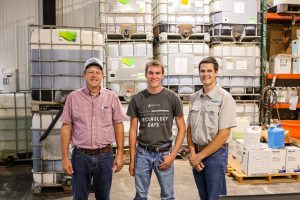By NutraDrip • Summer 2025 Field Day
When most growers think about fertility, they think about pounds of N-P-K.
Luke Holst wants you to start with something else:
Your water.
Luke is part of the Calibrated Agronomy team out of Illinois and has been working closely with NutraDrip to dig into hundreds of irrigation water, rapid soil, and sap tests from across multiple states. At our 2025 Summer Field Day, he walked through how that data is changing the way we think about water quality, fertigation, and nutrient management with irrigation.
This blog recaps Luke’s key points and what they mean for your farm as you plan next year’s fertility strategy.
Who Is Luke Holst and What Is Calibrated Agronomy?
Luke Holst – Data & Analysis, Calibrated Agronomy (Illinois location)
Calibrated Agronomy works with growers across the Midwest to:
- Interpret irrigation water tests, rapid soil tests, and sap tests
- Design fertility and fertigation strategies that fit real-world water quality
- Integrate biology, soil health, and economics into practical agronomy plans
In partnership with NutraDrip, Luke and the Calibrated team have built a growing dataset on:
- How irrigation water quality impacts soil mineral balance
- How water treatments and acids change the soil solution
- How much of that actually shows up in the plant (sap tests)
The goal is simple:
Use data to make irrigation water and fertility dollars work harder for every acre.
Why Irrigation Water Quality Matters More Than pH
Most growers look at pH on a water report and decide if their water is “good” or “bad.” Luke’s message:
pH matters, but it does not tell the whole story.
In their NutraDrip + Calibrated dataset (100+ water sites, 700+ rows of data), pH across multiple states mostly sat between 7.0–8.0. That range looked fine—but the crops told a different story.
Luke’s “Water Risk Factor”
To actually score irrigation water quality, Luke built a multi-dimensional “water risk factor” that looks at:
- SAR (Sodium Absorption Ratio) – how sodium will behave in the soil
- RSC (Residual Sodium Carbonate) – “hidden” bicarb-related sodium risk
- Salinity & chloride load
- Total dissolved solids (TDS)
- pH (still part of the story)
- Sulfate load
These pieces get combined into a water risk score:
- Low–Moderate Risk Water →
- Responds well to small amendment rates
- Good candidates for water treatment + fertigation
- High–Severe Risk Water (“ugly water”) →
- High sodium, chloride, and mineral loads
- Harder to treat just by “tweaking” the water
- Requires remediation, not just amendments
“Your water is what your soil becomes. If you keep putting poor-quality water on year after year, you eventually have a soil problem—not just a water problem.”
Step 1: Bench Testing – Titration Curves and Economics Before You Spend
From there, Luke builds a simple table:
- “To reach pH X, it will cost $Y per ¼” or ½” of water applied.”
This allows growers to see:
- Is this water economical to amend?
- How “hard” is this water to move?
- Are we in a “go zone” or “no-go zone” for certain amendments?
Because NutraDrip and Calibrated run multiple products through the same water—
they can compare:
- Sulfuric vs. phosphoric acid
- UAN vs. urea vs. urea-sulfuric blends
- Calibrated products like Backbone (carbon / fulvic-based)
- Different treatment rates and combinations
Result:
You’re not guessing in the field. You’re testing first, then writing the check.
Step 2: Rapid Soil Tests – What Happens When Your Water Hits Your Soil
After bench work, Luke uses rapid soil tests to see how water changes the soil solution.
They always run two versions:
- DI water (deionized) – simulates clean rainfall
- Your Irrigation water – real pivot or drip water, with or without treatment
Comparing the two shows what your irrigation water is actually doing.
What the Data Is Showing Across the Network
From their 2025 dataset, some patterns are becoming clear:
- Calcium
- Often increases with irrigation water and with acid treatments
- That can be good—up to a point
- Magnesium
- Moves both directions; heavily soil- and water-dependent
- Sodium
- When it goes up, it goes up big
- Some sites jump from ~50 ppm to 300+ ppm in the soil solution
- Long-term: sodium buildup under the pivot when compared to dry corners
- Potassium
- Frequently drops with irrigation
- Water antagonisms and forms of applied K make it harder to keep available
- Chloride & Sulfur
- Many waters bring significant loads of both
- Chloride and sulfate can become major antagonisms at higher levels
On the anion side, phosphorus is the consistent challenge:
In general, irrigation water tends to push phosphorus out of the soil solution rather than help you keep it available.
That’s why Luke often favors phosphoric-based acids to both:
- Treat water, and
- Lift P in the soil water solution instead of piling on more sulfur and making the P problem worse.
Step 3: Sap Testing – What Nutrients Actually Make It Into the Plant
Rapid soil tests tell us what is in the soil solution.
Sap tests tell us what’s making it into the plant.
Calibrated and NutraDrip use sap testing to track:
Nitrogen forms (nitrate vs. ammonium vs. protein N)
Phosphorus and potassium levels in the plant
Micronutrients (Fe, Zn, Mn, Cu, etc.)
How these shift through the season under different water and weather patterns
The Nitrogen Bottleneck & “Rapid Growth Syndrome”
In 2025 across parts of Illinois, Luke saw the same pattern repeatedly:
Warm, dry April → N fertilizer converting and becoming available
Then a cool, cloudy May → mineralization slows down
Soils drop into the low 50s °F te and ammonium
But without enough sulfur and micronutrients, they stop converting N into protein
On sap tests, this shows up as:
Sky-high nitrate and ammonium (far above “OK” thresholds)
Protein N and total N start collapsing
Micronutrients (zinc, copper, etc.) are deficient
Phosphorus trends low
That combination leads to what many called rapid growth syndrome / tassel wrap / buggy whip—plants flooded with raw nitrogen, but nutritionally unbalanced.
Luke’s takeaway:
Micronutrients + sulfur are critical for nitrogen assimilation.
Drip irrigation and fertigation give you a way to spoon-feed those pieces when the plant needs them, instead of front-loading everything and hoping the weather cooperates.
Sulfur: The Quiet Driver of Nutrient Uptake
One of the most interesting correlations in Luke’s dataset: sulfur.
When he ran a correlation matrix across all their sap tests, sulfur stood out:
When sulfur levels in the plant go up, most other nutrients trend up with it.
The only two that diverge (go down as sulfur goes up) are:
Nitrate
Ammonium
That’s exactly what you want to see if your goal is moving N into protein, not just stacking nitrate in the plant.
But there’s a catch.
Many irrigation waters are loaded with sulfur, yet the sap tests don’t show sulfur in a usable sulfate form. Lab numbers on water don’t always tell you the species of sulfur, and not all forms are equally useful to the plant.
So for Luke, sulfur isn’t a “check the box” item.
It’s a:
Key part of the fertility program, and
A nutrient he wants to see in sap tests, not just on water reports.
That’s why his plans often include both:
Water treatment strategies that don’t overload sulfur in the wrong form, and
Elemental S or other sulfur sources that reliably supply the plant.
Biology, Residue, and Disease: Don’t Forget the Microbes
Water and nutrients are only part of the picture. Luke also highlighted:
Tight disease pressure in 2025 (tar spot, rust, leaf diseases in corn)
How much of that disease load is carried on crop residue
The role of biological products and residue management in breaking those cycles
In one Illinois case study, applying a residue-focused biological product to half a field:
Reduced residue on the treated side by ~1.37 tons/acre in 6–8 months
Helped set up the next year’s crop with less disease inoculum and more active biology
For Luke and the Calibrated team, biology is not “magic.” It’s a tool:
Most biological products do not work if they’re not understood and placed correctly
Some have proven, sequenced strains that are:
Sodium-consuming / salinity-helping
Phos-solubilizing
Residue-breaking
Those tools are especially useful once you cross the line from “interdiction” (preventing a problem) into “remediation” (fixing one that’s already built up).
What Growers Should Do Before Next Season
Luke ended with some very practical steps any irrigated grower can take.
- Pull Water and Soil Samples the Right Way
- Send in irrigation water samples from each well or source
- Pull soil samples from the zone that actually receives the irrigation
- Consider paired samples:
- Under the pivot / drip zone
- Dry corners or non-irrigated areas
Comparing DI water vs. irrigation water and pivot vs. dry corners can reveal:
- Long-term sodium and chloride buildup
- Whether your water quality has already changed your soil
- Do a Rapid Soil Test Before Things Cool Off
Luke recommends rapid soil tests in the fall while biology is still active, especially if:
- You want a snapshot of current mineralization and balance
- You plan to test different acid or nitrogen sources over the winter
- You want to build a custom “what actually moves the needle” database for your farm
- Rethink Phosphorus and Potassium Strategy
Given high P prices and the way irrigation water often antagonizes phosphorus:
- Consider pulling back some fall P, especially on built-up soils
- Shift dollars into:
- In-season P through fertigation or Y-drops
- Water treatment with phosphoric-based acids
- Targeted potassium sources that fit your chloride situation
- Use Water Treatment Where It Actually Pays
On moderate-risk waters, small, well-chosen rates of:
- Acids (often phosphoric-based)
- Carbon / fulvic products like Backbone
- Gypsum or other soil amendments in stubborn cases
…can dramatically improve:
- Water quality as it hits the soil
- Nutrient availability and balance in the soil solution
On high-risk “ugly” water, be prepared to think in terms of:
- Remediation, not just “tweaking the water”
- Biology + gypsum + long-term strategies, not just more gallons of acid
Partnering with Calibrated Agronomy & NutraDrip
Luke closed his talk by stressing that this is not a one-and-done project.
NutraDrip and Calibrated Agronomy are:
- Adding more water, soil, and sap data every year
- Refining the water risk factor and treatment playbook
- Tying all of it back to real-world yield and ROI
If you’re:
- Irrigating with well water, surface water, or manure blends
- Fighting sodium, sulfur, or chloride issues
- Struggling to keep phosphorus and potassium in the plant
- Seeing disease and residue stacking up year over year
…it’s a good time to get a data-driven look at your water, soil, and sap.
Ready to Find Out If Your Water Is “Good, Bad, or Ugly”?
Here’s your next step:
- Pull an irrigation water sample from each source
- Pull a soil sample from under the pivot or drip zone (and dry corners, if you can)
- Reach out to NutraDrip and ask about:
- A rapid soil test + water test package
- Working with Calibrated Agronomy to interpret the results
- Building a 2026 fertigation and amendment plan around your actual water risk
Your fertilizer program doesn’t start at the tender or the spreader. It starts at the well.




